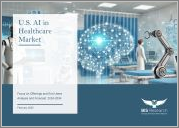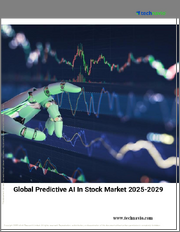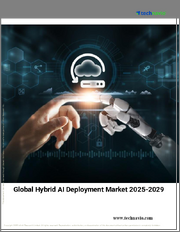
|
시장보고서
상품코드
1661295
미국의 헬스케어 AI 시장 : 제공별, 최종사용자별 분석 및 예측(2024-2034년)U.S. AI in Healthcare Market: Focus on Offerings and End Users - Analysis and Forecast, 2024-2034 |
||||||
미국의 헬스케어 AI 시장 규모는 2023년 52억 5,430만 달러에서 예측 기간 동안 40.41%의 연평균 성장률(CAGR)을 기록하며 2034년에는 2,296억 9,940만 달러로 급성장할 것으로 예상됩니다.
이러한 괄목할 만한 성장은 의료 서비스 제공을 근본적으로 재편하고 있는 급속한 기술 발전에 힘입은 바 큽니다. 머신러닝과 딥러닝 알고리즘의 획기적인 발전은 정밀한 진단 도구와 개인화된 치료 계획의 개발을 촉진하여 환자 치료 결과와 업무 효율성을 개선하고 있습니다. 웨어러블 기기 및 원격의료와 같은 디지털 헬스 솔루션의 통합은 AI의 능력을 더욱 확장하여 실시간 모니터링 및 원격 환자 관리를 가능하게 합니다. 민간 및 공공 기관의 막대한 투자가 연구개발을 가속화하고 혁신과 적용의 지속적인 사이클을 촉진하고 있습니다. 또한, 전통적인 헬스케어 프레임워크 내에서 AI 솔루션을 원활하게 도입할 수 있는 길을 열어주는 규제적 지원 환경과 업계 이해관계자들 간의 전략적 파트너십이 지식의 교환과 기술 통합을 촉진하고 있습니다. 이러한 요인들은 향후 10년간 미국의 헬스케어 AI 시장의 급격한 성장을 뒷받침하고 견고한 생태계를 조성할 것입니다.
| 주요 시장 통계 | |
|---|---|
| 예측 기간 | 2024-2034년 |
| 2024년 평가 | 77억 1,000만 달러 |
| 2034년 예측 | 2,297억 달러 |
| CAGR | 40.41% |
제공 부문별로는 소프트웨어 및 서비스 부문이 우세:
제공 부문별로는 소프트웨어 및 서비스 부문이 2023년 72%의 점유율을 차지하며 시장을 주도했습니다. 소프트웨어 및 서비스는 예측 분석 및 진단 지원에서 전자 의료 기록 통합 및 자연어 처리까지 종합적인 솔루션 제품군을 제공하여 의료 서비스 제공자의 임상적 의사결정과 업무 효율성 향상을 돕습니다. 이러한 도구들은 실시간 데이터 처리와 개인화된 치료 계획을 가능하게 하여 궁극적으로 환자 결과 개선과 비용 절감에 기여합니다. 다양한 애플리케이션을 원활하게 통합하여 성능을 최적화하는 고급 운영체제와 마찬가지로, 이러한 소프트웨어 기반 솔루션은 헬스케어 디지털 혁신의 근간이 되어 워크플로우를 간소화하고, 보다 빠르고 정확한 진단을 촉진합니다. 촉진합니다. 디지털 헬스 혁신에 대한 지속적인 투자로 소프트웨어와 서비스의 중요성은 계속 확대될 것이며, 보다 효율적이고 환자 중심의 헬스케어 환경을 조성하는 데 있어 매우 중요한 역할을 할 것으로 예상됩니다.
최종사용자별로는 기타 의료 서비스 제공자 부문이 우세:
최종사용자별로 보면 기타 의료 서비스 제공자 부문이 2023년 46%의 점유율을 차지하며 시장을 주도했습니다. 기타 의료 서비스 제공자는 전문 진단 센터, 외래 진료소, 외래 진료소, 외래 진료소, 독립 실험실 등을 포함하는 그룹입니다. 이들 기관은 진단 정확도를 높이고, 검사 시간을 단축하고, 더 나은 환자 결과를 위해 치료 프로토콜을 조정하기 위해 AI 기반 검사 솔루션을 점점 더 많이 채택하고 있습니다. 고급 알고리즘과 실시간 데이터 분석을 활용하여 기존 검사 방법으로는 간과할 수 있는 패턴과 이상 징후를 식별할 수 있습니다. 이러한 의료 서비스 제공자들은 상호 연계된 의료 시스템의 전문가 네트워크와 같이 최첨단 진단 기술에 대한 접근성을 확대하고, 의료의 디지털 혁신을 촉진하며, 궁극적으로 보다 효율적이고 개인화된 의료 서비스를 제공하는 데 중요한 역할을 하고 있습니다.
시장 분류
세분화 1 : 제품별
- 하드웨어
- 소프트웨어 서비스
세분화 2 : 최종사용자별
- 의료 서비스 제공자
- 헬스케어 보험사
- 환자
- 기타 의료 서비스 제공자
미국의 헬스케어 AI 시장을 조사했으며, 주요 동향, 시장 영향요인 분석, 법·규제 환경, 기술개발·특허 동향, 사례 분석, 시장 규모 추정 및 예측, 각종 부문별 상세 분석, 경쟁 구도, 주요 기업 개요 등의 정보를 정리하여 전해드립니다.
목차
주요 요약
범위와 정의
제1장 시장 : 업계 전망
- 시장 개요
- 헬스케어 AI의 도입
- 헬스케어 AI 활용 사례
- AI에서 사용되는 기술
- 시장 동향과 채용률
- 디지털 기술의 도입 확대
- 자금 조달의 대처 확대
- 헬스케어 AI의 새로운 용도
- AI의 도입과 시장 준비
- 참여 장벽과 기회
- 사례 연구와 영향
- 규제 상황
- 시장 역학 개요
- 영향 분석
- 시장 성장 촉진요인
- 시장 과제
- 시장 기회
제2장 미국의 헬스케어 AI 시장 : 제공별
- 하드웨어
- 소프트웨어·서비스
제3장 미국의 헬스케어 AI 시장 : 최종사용자별
- 헬스케어 제공자
- 헬스케어 보험자
- 환자
- 기타 헬스케어 제공자
제4장 시장 : 경쟁 벤치마킹 및 기업 개요
- 주요 전략과 개발
- 투자 상황(자금 조달과 M&A 활동)
- 주요 AI 제품과 스타트업
- Viz.ai
- Abridge
- Insilico Medicine
- Tempus
- 기업 개요
- International Business Machines Corporation
- Google LLC
- Microsoft Corporation
- Amazon.com, Inc.
- NVIDIA Corporation
- GE HealthCare
- Koninklijke Philips N.V.
- Tempus Labs, Inc.
- PathAI
제5장 조사 방법
ksm 25.03.11Introduction of U.S. AI in Healthcare Market
The U.S. AI in healthcare market, initially valued at $5,254.3 million in 2023, is set for substantial growth, projected to surge to $229,699.4 million by 2034, marking a remarkable compound annual growth rate (CAGR) of 40.41% over the period from 2024 to 2034. This impressive trajectory is fuelled by rapid technological advancements that are fundamentally reshaping healthcare delivery. Breakthroughs in machine learning and deep learning algorithms drive the development of highly accurate diagnostic tools and personalized treatment plans, improving patient outcomes and operational efficiencies. The integration of digital health solutions, such as wearable devices and telemedicine, further expands the capabilities of AI, enabling real-time monitoring and remote patient management. Significant investments from both private and public sectors are accelerating research and development, fostering a continuous cycle of innovation and application. Additionally, a supportive regulatory environment is paving the way for seamless adoption of AI solutions within traditional healthcare frameworks, while strategic partnerships among industry stakeholders are facilitating knowledge exchange and technological integration. Together, these factors create a robust ecosystem that not only supports but actively propels the rapid growth of the U.S. AI in healthcare market over the coming decade.
Market Introduction
| KEY MARKET STATISTICS | |
|---|---|
| Forecast Period | 2024 - 2034 |
| 2024 Evaluation | $7.71 Billion |
| 2034 Forecast | $229.70 Billion |
| CAGR | 40.41% |
The AI in healthcare market in the U.S. has been experiencing significant growth, driven by rapid technological innovation, evolving regulatory support, and a surge in strategic investments. Advanced AI applications, including predictive analytics and sophisticated diagnostic tools, are transforming traditional healthcare practices by enabling more accurate and timely clinical decision-making. This shift is further bolstered by the integration of digital health solutions, such as wearable devices and telemedicine, which facilitate continuous patient monitoring and remote care. Additionally, healthcare providers are increasingly embracing data-driven approaches to enhance personalized treatment protocols and improve overall patient outcomes. As these technological advancements align with a broader move towards preventive care and operational efficiency, the U.S. AI in healthcare market is witnessing a paradigm shift reshaping healthcare delivery's future.
Industrial Impact
The U.S. AI in healthcare market is set for steady growth, driven by rapid technological advancements, supportive regulatory frameworks, and increased investments in digital health innovation. Emerging AI algorithms and machine learning platforms are enhancing diagnostic accuracy and enabling personalized treatment plans, while streamlined government initiatives and evolving FDA guidelines are creating an environment conducive to integrating AI into clinical practices.
The industrial impact of AI in healthcare is profound, fundamentally reshaping clinical processes and operational efficiencies across the sector. AI-driven solutions have been shown to reduce diagnostic errors by up to 30%, leading to more accurate treatments and significant cost savings, bolstering the $500 million in venture capital funding secured by U.S.-based healthcare AI startups in 2023. This influx of investment is accelerating innovation, paving the way for advanced diagnostic tools and predictive analytics that are streamlining workflows in hospitals and clinics alike. Moreover, governmental initiatives, including those by the U.S. Department of Health and Human Services, project up to $150 billion in annual savings by 2026 through optimized treatment protocols and reduced misdiagnoses. These factors collectively are not only enhancing patient outcomes but are also transforming healthcare institutions into agile, data-driven entities, much like a well-orchestrated industrial upgrade that replaces outdated systems with next-generation technologies, thereby setting new benchmarks for efficiency and quality in healthcare delivery.
Market Segmentation:
Segmentation 1: by Offering
- Hardware
- Software and Services
Software and Services Offering Segment to Dominate the U.S. AI in Healthcare Market (by Offering)
Based on offering, the U.S. AI in healthcare market was led by the software and services offering segment, which held a 72% share in 2023. Software and services offer a comprehensive suite of solutions, ranging from predictive analytics and diagnostic support to electronic health record integration and natural language processing, that empower healthcare providers to enhance clinical decision-making and operational efficiency. These tools enable real-time data processing and personalized treatment planning, ultimately contributing to improved patient outcomes and significant cost savings. Much like an advanced operating system that seamlessly integrates various applications to optimize performance, these software-driven solutions serve as the backbone of digital transformation in healthcare, streamlining workflows and facilitating faster, more accurate diagnoses. With ongoing investments in digital health innovation, the prominence of software and services is expected to continue expanding, solidifying its pivotal role in shaping a more efficient and patient-centric healthcare landscape.
Segmentation 2: by End User
- Healthcare Providers
- Healthcare Payers
- Patients
- Other Healthcare Providers
Other Healthcare Providers Segment to Dominate the U.S. AI in Healthcare Market (by End User)
Based on the end user, the U.S. AI in healthcare market was led by the other healthcare providers segment, which held a 46% share in 2023. Other healthcare providers are a diverse group that includes specialized diagnostic centers, outpatient clinics, ambulatory care centers, and independent laboratories. These entities are increasingly adopting AI-driven testing solutions to enhance diagnostic accuracy, reduce turnaround times, and tailor treatment protocols for better patient outcomes. By leveraging advanced algorithms and real-time data analytics, they are able to identify patterns and anomalies that might otherwise be overlooked in traditional testing methods. Much like a network of interconnected specialists in a well-coordinated healthcare system, these providers play a crucial role in expanding access to cutting-edge diagnostic technologies, driving the digital transformation of healthcare, and ultimately contributing to more efficient and personalized care delivery.
Recent Developments in the U.S. AI in Healthcare Market
- In October 2023, Medtronic Plc partnered with Nvidia to build an AI platform for medical devices.
- In July 2022, Amazon.com, Inc. acquired One Medical for $3.9 billion, expanding AI-enabled primary care.
Demand - Drivers, Challenges, and Opportunities
Market Drivers:
Growing Need for Early Detection and Diagnosis: The growing need for early detection and diagnosis has become increasingly critical as the complexity of healthcare challenges continues to rise. Timely identification of diseases allows for prompt and targeted intervention, which can significantly enhance treatment effectiveness. Innovative diagnostic technologies, particularly AI-powered, enable clinicians to detect subtle changes and early warning signs that might otherwise go unnoticed. Early diagnosis paves the way for personalized care plans and reduces the risk of severe complications. By shifting the focus toward prevention rather than reaction, healthcare systems are better equipped to manage patient outcomes proactively. This proactive approach alleviates long-term burdens on healthcare resources and minimizes overall treatment costs. Ultimately, the emphasis on early detection is driving a transformative shift toward precision medicine and a more sustainable future for patient care.
Market Challenges:
Concerns Regarding Data Privacy: Data privacy concerns in healthcare have become increasingly significant as AI systems process vast amounts of sensitive patient information. The aggregation of data from diverse sources introduces vulnerabilities that can lead to unauthorized access and data breaches, putting personal health records at risk. Regulatory frameworks, although robust, often struggle to keep pace with rapid technological advancements and the complexities of cross-border data flows. This situation underscores the challenge of balancing the benefits of AI-driven healthcare innovations with the imperative to protect patient confidentiality. Healthcare organizations are, therefore, investing heavily in cybersecurity measures, such as advanced encryption and data anonymization, to mitigate these risks. At the same time, ongoing updates to privacy regulations and best practices are essential to address evolving cyber threats. Ultimately, maintaining stringent data protection protocols is critical to preserving patient trust and ensuring the ethical use of AI in healthcare.
Market Opportunities:
Pain Management and Personalized Care: AI-driven innovations are revolutionizing pain management by offering highly personalized care tailored to each patient's unique needs. Continuous monitoring through wearable devices and sensors captures real-time data on pain levels, enabling clinicians to adjust treatments promptly and effectively. Advanced data analytics identify individual pain triggers and patterns, paving the way for targeted and efficient interventions. Enhanced diagnostic imaging further refines these approaches by accurately pinpointing the sources of pain, which supports the development of more precise treatment strategies. Integration with telemedicine platforms also plays a crucial role, allowing remote monitoring and timely consultations that ensure care remains responsive and accessible. By combining historical patient data with live insights, clinicians can create dynamic pain management plans that evolve with each patient's condition. Ultimately, this personalized approach improves pain control and enhances overall quality of life, empowering patients through tailored, proactive care.
How can this report add value to an organization?
Product/Innovation Strategy: The U.S. AI in healthcare market has been extensively segmented based on various categories, such as offerings and end users. This can help readers understand which segments account for the largest share and which are well-positioned to grow in the coming years.
Growth/Marketing Strategy: Mergers, acquisitions, and product launches accounted for the maximum number of key developments, i.e., nearly 41.67% of the total developments in the U.S. AI in healthcare market were between January 2019 and December 2023.
Competitive Strategy: The U.S. AI in healthcare market has numerous established players with product portfolios. Key players in the U.S. AI in healthcare market analyzed and profiled in the study involve established players offering products for U.S. AI in healthcare.
Methodology
Key Considerations and Assumptions in U.S. AI in Healthcare Market Engineering and Validation
- The base year considered for the calculation of the U.S. AI in healthcare market size is 2023. A historical year analysis has been done for the period FY2021-FY2022. The U.S. AI in healthcare market size has been estimated for FY2023 and projected for the period FY2024-FY2034.
- The scope of this report has been carefully derived based on interactions with experts in different companies. This report provides a market study of upstream and downstream technologies of the U.S. AI in healthcare market.
- The U.S. AI in healthcare market contribution of U.S. AI in healthcare is anticipated to be launched and calculated based on a historical analysis of the solutions.
- The company's revenue has been referenced from their annual reports for FY2022 and FY2023. For private companies, revenues have been estimated based on factors such as inputs obtained from primary research, funding history, market collaborations, and operational history.
- The U.S. AI in healthcare market has been mapped based on the available U.S. AI in healthcare data. This report has considered and profiled all the key companies with significant offerings in this field.
Primary Research:
The primary sources involve industry experts in U.S. AI in healthcare, including the market players offering products and services. Resources such as CEOs, vice presidents, marketing directors, and technology and innovation directors have been interviewed to obtain and verify both qualitative and quantitative aspects of this research study.
The key data points taken from the primary sources include:
- Validation and triangulation of all the numbers and graphs
- Validation of the report's segmentation and key qualitative findings
- Understanding the competitive landscape and business model
- Current and proposed production values of a product by market players
- Validation of the numbers of the different segments of the U.S. AI in healthcare market in focus
- Percentage split of individual markets for regional analysis
Secondary Research
Open Sources
- Certified publications, articles from recognized authors, white papers, directories, and major databases, among others
- Annual reports, SEC filings, and investor presentations of the leading market players
- Company websites and detailed study of their product portfolio
- Gold standard magazines, journals, white papers, press releases, and news articles
- Paid databases
The key data points taken from the secondary sources include:
- Segmentations and percentage shares
- Data for market value
- Key industry trends of the top players of the U.S. AI in healthcare market
- Qualitative insights into various aspects of the U.S. AI in healthcare market, key trends, and emerging areas of innovation
- Quantitative data for mathematical and statistical calculations
Key Market Players and Competition Synopsis
Profiled companies have been selected based on inputs gathered from primary experts, who have analysed company coverage, product portfolio, and market penetration.
Some prominent names established in this market are:
- International Business Machines Corporation
- Google LLC
- Microsoft Corporation
- Amazon.com, Inc.
- NVIDIA Corporation
- GE HealthCare
Table of Contents
Executive Summary
Scope and Definition
1 Market: Industry Outlook
- 1.1 Market Overview
- 1.1.1 AI Adoption in Healthcare
- 1.1.2 AI Use Cases in Healthcare
- 1.1.2.1 Diagnostics and Imaging
- 1.1.2.2 Drug Discovery and Development
- 1.1.2.3 Personalized Medicine and Treatment Plans
- 1.1.2.4 AI in Patient Management and Virtual Healthcare
- 1.1.2.5 Remote Patient Monitoring (RPM)
- 1.1.2.6 Hospital Operations and Administrative Automation
- 1.1.2.7 AI in Surgery and Robotics
- 1.1.2.8 AI for Disease Prediction and Early Detection
- 1.1.3 Technology Used in AI
- 1.1.3.1 Machine Learning
- 1.1.3.2 Natural Language Processing (NLP)
- 1.1.3.3 Generative AI
- 1.1.3.4 Computer Vision
- 1.1.3.5 Image Analysis
- 1.2 Market Trends and Adoption Rates
- 1.2.1 Increasing Adoption of Digital Technology
- 1.2.2 Increasing Funding Initiatives
- 1.2.3 Emerging Applications of AI in Healthcare
- 1.3 AI Adoption vs Market Readiness
- 1.4 Entry Barriers and Opportunities
- 1.4.1 Barriers
- 1.4.1.1 Regulatory Uncertainty
- 1.4.1.2 Integration Complexity
- 1.4.1.3 Workforce Transition
- 1.4.1.4 Data Strategy
- 1.4.1.5 ROI Realization
- 1.4.2 Opportunities
- 1.4.2.1 Strategic Differentiation
- 1.4.2.2 New Services and Revenue Streams
- 1.4.2.3 Addressing Workforce Shortages
- 1.4.2.4 Collaboration and Ecosystem Building
- 1.4.1 Barriers
- 1.5 Case Studies and Impact
- 1.5.1 Stroke Care (Viz.ai)
- 1.5.2 Sepsis Early Detection-Mixed Results
- 1.5.3 Diagnostic Accuracy
- 1.5.4 Patient Satisfaction-AI Patient Communication
- 1.5.5 Telehealth Triage-Kaiser's Chatbot
- 1.6 Regulatory Landscape
- 1.6.1 Regulatory and Policy Landscape in the U.S.
- 1.6.2 EU vs. U.S. Differences
- 1.7 Market Dynamics Overview
- 1.7.1 Impact Analysis
- 1.7.2 Market Drivers
- 1.7.2.1 Growing Need for Early Detection and Diagnosis
- 1.7.2.2 The Rapid Proliferation of AI in the Healthcare Sector
- 1.7.2.3 Exponential Growth in Data Volume and Complexity Due to Surging Adoption of Digital Technologies
- 1.7.2.4 Operational Efficiency and Cost Reduction
- 1.7.3 Market Challenges
- 1.7.3.1 Concerns Regarding Data Privacy
- 1.7.4 Market Opportunities
- 1.7.4.1 Pain Management and Personalized Care
2 U.S. AI in Healthcare Market (by Offering), $Billion, 2023-2034
- 2.1 Hardware
- 2.2 Software and Services
3 U.S. AI in Healthcare Market (by End User), $Billion, 2023-2034
- 3.1 Healthcare Providers
- 3.2 Healthcare Payers
- 3.3 Patients
- 3.4 Other Healthcare Providers
4 Markets - Competitive Benchmarking & Company Profiles
- 4.1 Key Strategies and Development
- 4.1.1 Partnerships, Alliances, and Business Expansions
- 4.1.2 Funding Activities
- 4.1.3 Merger and Acquisition
- 4.1.4 New Offerings and Regulatory Approval
- 4.2 Investment Landscape (Funding and M&A Activity)
- 4.3 Major AI Products and Startups (2023-2025)
- 4.3.1 Viz.ai
- 4.3.2 Abridge
- 4.3.3 Insilico Medicine
- 4.3.4 Tempus
- 4.4 Company Profiles
- 4.4.1 International Business Machines Corporation
- 4.4.1.1 Overview
- 4.4.1.2 Top Products/Services
- 4.4.1.3 Top Competitors
- 4.4.1.4 Target Customers
- 4.4.1.5 Analyst View
- 4.4.2 Google LLC
- 4.4.2.1 Overview
- 4.4.2.2 Top Products/Services
- 4.4.2.3 Top Competitors
- 4.4.2.4 Target Customers
- 4.4.2.5 Analyst View
- 4.4.3 Microsoft Corporation
- 4.4.3.1 Overview
- 4.4.3.2 Top Products/ Services
- 4.4.3.3 Top Competitors
- 4.4.3.4 Target Customers
- 4.4.3.5 Analyst View
- 4.4.4 Amazon.com, Inc.
- 4.4.4.1 Overview
- 4.4.4.2 Top Products/ Services
- 4.4.4.3 Top Competitors
- 4.4.4.4 Target Customers
- 4.4.4.5 Analyst View
- 4.4.5 NVIDIA Corporation
- 4.4.5.1 Overview
- 4.4.5.2 Top Products/ Services
- 4.4.5.3 Top Competitors
- 4.4.5.4 Target Customers
- 4.4.5.5 Analyst View
- 4.4.6 GE HealthCare
- 4.4.6.1 Overview
- 4.4.6.2 Top Products/ Services
- 4.4.6.3 Top Competitors
- 4.4.6.4 Target Customers
- 4.4.6.5 Analyst View
- 4.4.7 Koninklijke Philips N.V.
- 4.4.7.1 Overview
- 4.4.7.2 Top Products/ Services
- 4.4.7.3 Top Competitors
- 4.4.7.4 Target Customers
- 4.4.7.5 Analyst View
- 4.4.8 Tempus Labs, Inc.
- 4.4.8.1 Overview
- 4.4.8.2 Top Products/ Services
- 4.4.8.3 Top Competitors
- 4.4.8.4 Target Customers
- 4.4.8.5 Analyst View
- 4.4.9 PathAI
- 4.4.9.1 Overview
- 4.4.9.2 Top Products/Services
- 4.4.9.3 Top Competitors
- 4.4.9.4 Target Customers
- 4.4.9.5 Analyst View
- 4.4.1 International Business Machines Corporation
5 Research Methodology
- 5.1 Data Sources
- 5.1.1 Primary Data Sources
- 5.1.2 Secondary Data Sources
- 5.1.3 Data Triangulation
- 5.2 Market Estimation and Forecast



















